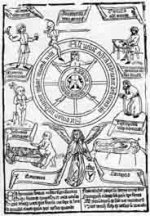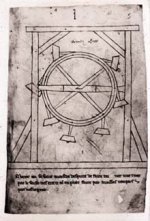I would like to share some of my thoughts about this wonderful card, with its creatures making the wheel turn by themselves, since nobody is forcing them to. This must bear some symbolic meaning; otherwise the image would respect the general depiction of Fortune’s wheels in medieval art, with the goddess Fortuna in charge of the motion! I guess they just don’t know they can stop it (I guess WE just don’t know we can stop it).
About number ten, I like to consider its meaning in two ways: as the number in itself, pointing out the idea of completion of a cycle and beginning of another, and as the graphic symbol, or X. The Tarot wheel in Marseilles decks has six rays (very similar to the Three of Wands picture), but some medieval Wheels of Fortune have four rays, in a way that strongly reminds me of this “X” card… I’m sorry for not being able to set a link to any of these images, but if someone really wants to see one, I’ll try to.
Well, a cross and a circle, probably the two more ancient symbols ever known, form a Solar Cross. Better then using my words, I’ll quote a simple text about it, pulled out from an internet site: “The Solar cross is probably the oldest religious symbol in the world, appearing in Asian, American, European, and Indian religious art from the dawn of history. Composed of a equal armed cross within a circle, it represents the solar calendar- the movements of the sun, marked by the solstices. Sometimes the equinoxes are marked as well, giving an eight armed wheel. (The swastika is also a form of Solar cross.)” (
http://altreligion.about.com/library/glossary/symbols/bldefssolar.htm). Another name for a Solar Cross is a Wheel Cross, mainly related to the Celtic tradition.
In the Christian world, this cross got to be represented as an X, I think, due to the symbolic of the Chi-Rho, a combination of the first two Greek letters in the name Christos, a P over an X, latter a P over a cross, often placed within a circle. The loop of the P eventually disappeared, and what remained was a simple cross within a circle. Anyway, and to return to the solar meaning of the Solar Cross, note that the X is the symbol of Light, and used as such in Alchemical notation.
Maybe this could be of some help for someone out there. I myself sense it might have a meaning, but am not sure of what it is. What strikes me the most is the X as a graphic symbol that attracts attention to its centre: the place of no-motion, the only part of the wheel where one can escape from its perpetual turning. God’s place. Then, the card’s number – in a visual sense – reminds me of another symbolic use of an X – a mark, like saying “Hey, it’s here, this is the place”. Like in the Two of Wands, actually.
And then, there is the Sphinx.
The famous riddle of the Sphinx is in itself related to the Wheel of Fortune, of course: "What has one voice, and is four-footed, two-footed and three-footed?" Oedipus answer, "Man, who in childhood creeps on hands and knees, in manhood walks erect, and in old age with the aid of a staff", equals the traditional representations of man ascending, trying to maintain equilibrium on top, and descending the wheel. In medieval art, the Wheel of Fortune is several times depicted as the Wheel of Life (the Ages of Man), whether this happens by inaccuracy, or with a precise symbolic intent.
And, after all, Oedipus got to be made king after solving the enigma! What happened to him latter on, and the meaning of his story as an allegory of Fate, is an issue I believe many have already explored. I won’t also discuss the differences between the Greek and the Egyptian Sphinx; as far as I know, the riddle relates to the Greek one but is often applied to the Egyptian, because of her enigmatic nature. What matters is the way their mixed story was understood in occidental art and symbology – but it could be important to consider that the Egyptian sphinxes are rather benevolent beings, unlike the Greek versions, at least to those who respect the secrets that they guard…




